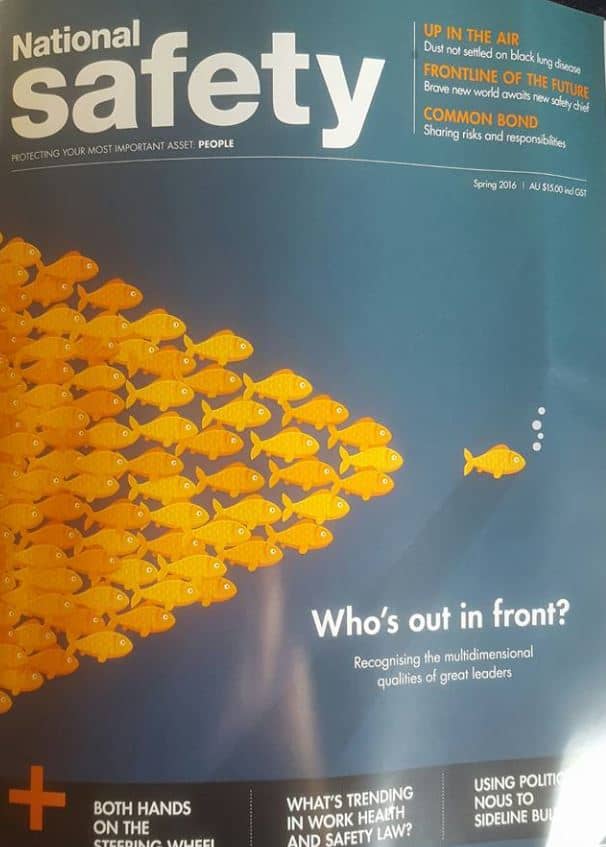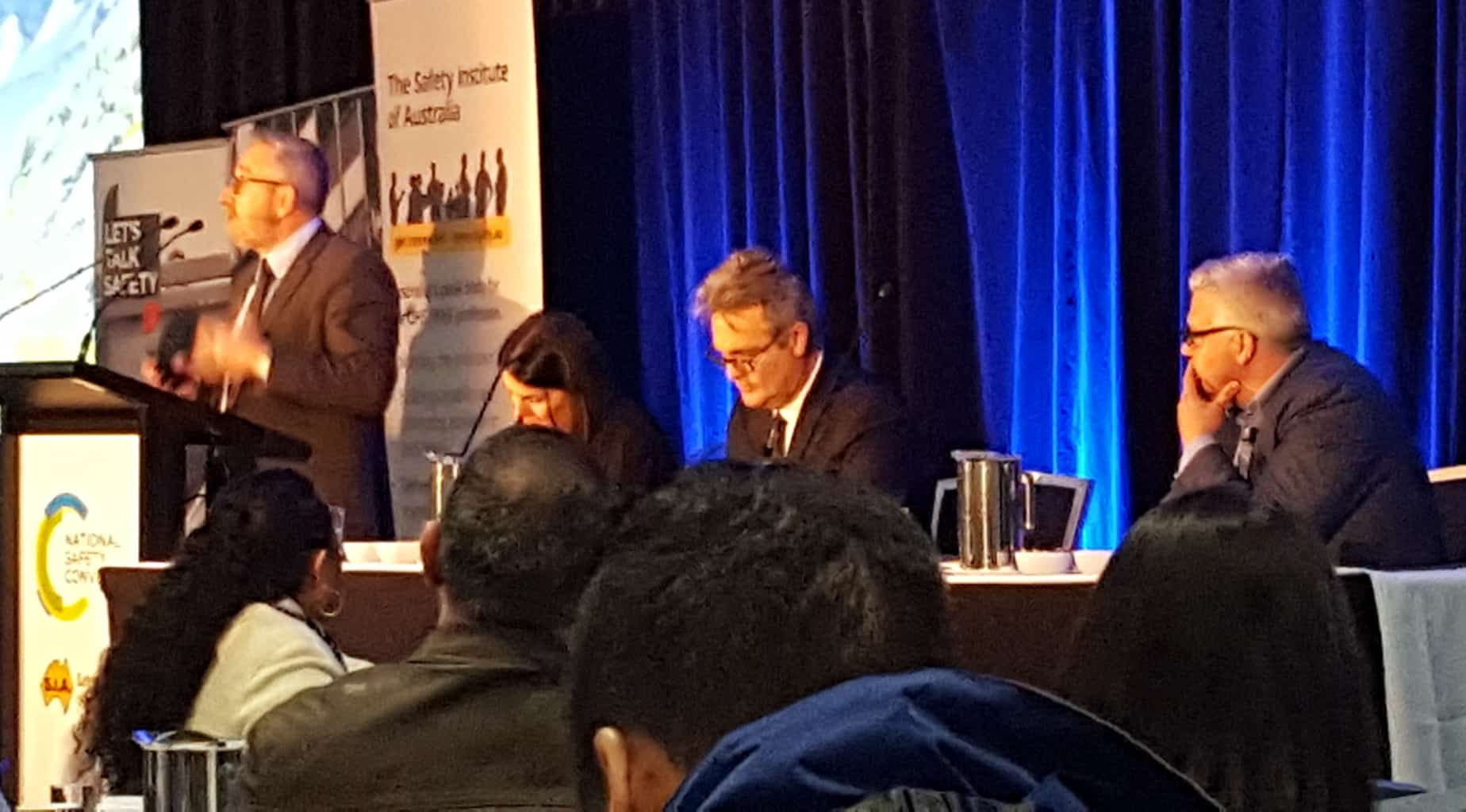Part 2 of the Cabbage Salad and Safety podcast’s discussion on managing drugs and alcohol at work is now available.

Part 2 of the Cabbage Salad and Safety podcast’s discussion on managing drugs and alcohol at work is now available.

The Spring 2016 edition of National Safety magazine includes a cover story on leadership written by me. In it John Lacey insists that safety leadership begins at the top. This position is supported by many business and occupational health and safety (OHS) advocates but this seems to me to be based on a misunderstanding of leadership.
 In response to a question about leadership in small- to medium-sized businesses, Lacey said that leadership “applies to all”:
In response to a question about leadership in small- to medium-sized businesses, Lacey said that leadership “applies to all”:
“[Leadership] is not different but how to apply it will be different. The start must be from the top down. The basic values, behaviours, knowledge and systems will be defined by the organisation no matter how large or small it is.”
This is remarkably like safety culture and my response is that leadership can be displayed by anyone at any level of a company or society and can manifest at any organisational level. The fact is that it is easier to sell a commodified leadership to executives as they are expected to show leadership in times of crisis or stockmarket uncertainty and most of us translate that into leadership of safety.
Leadership, as with most elements of OHS, takes time and effort – sometimes over generations. This is particularly so with anything concerning corporations that are wary of change unless that change supports profit and shareholder returns. (I would argue safety increases profits and company value but this is an argument than struggles for traction)
The most abused aphorism used to justify this focus on executive leadership is that “a fish rots from the head down”. Nonsense. As this website states, it is the guts of a fish that rots first.
 The attention given to senior executive leadership is an organisational echo of the economic trickle-down theory which has been roundly dismissed as flawed and, in some instances, has contributed to increasing socio-economic inequality.
The attention given to senior executive leadership is an organisational echo of the economic trickle-down theory which has been roundly dismissed as flawed and, in some instances, has contributed to increasing socio-economic inequality.
Lacey acknowledges that anybody within an organisation can lead although leadership starts from the top. He supports my contention that leadership occurs at all levels of a business and that actions show leadership and safety, probably, more effectively and cheaper than any training session. Lacey says
“…even the gesture of picking-up litter or wearing the correct [personal protective equipment] in front of others in the work team can be seen as a form of leadership. Leading by example is an old but such a true saying.”
These actions are the best way of improving workplace safety and showing leadership, and for the least cost. Safety should be improved by actions rather than PowerPoint.
[Note: please support National Safety magazine if you can. It is not available online and only through subscription but it is one of the few hard copy OHS magazines left in Australia and one of the few, if not the last, that actually pays its writers (not as much as we’d like but that’s the continuous battle of the freelance writer). This stance is keeping advertorials at bay and gives National Safety an integrity that is often missing in other safety publications]
On October 7 2016, Victoria’s trade union movement held a Young Worker Conference. The major public statement from that conference was the launch of a survey report called Young Workers Health and Safety Snapshot. The report has received some mainstream press which is not unusual for this type of trade union member survey. Almost twenty…
The second session of the SIA National Convention is flatter than the the first, not because it is not interesting but because it is providing us with the social context for occupational health and safety (OHS) rather than challenging the OHS profession.
Bernard Salt is a very high profile demographer whose job is almost entirely about providing social context to whatever we do. He mentioned OHS specifically only four times and then primarily to do with driving trucks but the age data Salt presented shows the need for improvement in the health and wellbeing of the workforce so that quality of life can extend in line with the extended period of our lives.
 Peter Gahan (pictured right, speaking)of the Centre of Workplace Leadership is a regular speaker at the Safety Institute of Australia’s conferences. His outline reflects the theme of this conference by disrupting our sense of security and career.
Peter Gahan (pictured right, speaking)of the Centre of Workplace Leadership is a regular speaker at the Safety Institute of Australia’s conferences. His outline reflects the theme of this conference by disrupting our sense of security and career.
The challenge comes from how we respond to this unease. If we curl up on the couch to binge watch a show, the career is over. We need to look for the opportunities that the disruption offers but this may require us to reassess, if not throw out, the foundations of our profession or the dreams on which we chose our career.
Richard Coleman is well known in the Australian OHS profession through his prominent safety career. His attraction as a conference speaker was on display because he was able to adjust his presentation to accommodate the examples and context that previous speakers addressed. Coleman focused on the digital disruption, particularly as it affects blue collar occupations. He believes that some of these jobs will go within the next five years.
Coleman’s focus on digital disruption provided a great summary of the OHS application of augmented reality and wearable technology. The latter has the best opportunity for safety improvement, particularly in the area of manual handling. Sensor technology can provide better levels of information and in real time that allows immediate interventions at times of great risk.
What these speakers and the panel are all about is to think creatively and think big. Fantasise about your job and the tasks you do now and whether they will exist in ten years and how you can change them now to prepare for the future. If your job leads to a dead-end, change the job. It seems easier to do this now, than ever before
In a comment to a recent blog article Gregor McGhee asked:
“Just out of curiosity can you recommend any books for comparison with respect to presentation, footnotes, references and endnotes?”
Most books related to occupational health and safety (OHS) are written by academics for an academic audience so there are clear referencing protocols and styles with which that readership will be familiar and comfortable. The challenge comes when academics are asked to write for a lay audience for whom concepts must be explained and backgrounds and context provided.
But there is a similar challenge to OHS regulators who provide guidance material that often derives from academic research but also for the legalities of safety legislation. SafetyAtWorkBlog was able to talk with Jackie McAdam, a freelance editor, designer and writer who has worked for the UK’s OHS regulator, the Health and Safety Executive (HSE).
Format and Language
In Carsten Busch’s book, he chooses to use endnotes for references but an ABC system for footnotes. This non-conformity is part of the reason the book is a challenging read.
NIOSH has a program of Research to Practice (R2P) where research grants are given, or work commissioned, on the understanding that the research will also be “translated” into a format and language that allows for the research findings to be applied in the real world. NIOSH says it:
“…..collaborates with partners and stakeholders to:
Focussing on the communication element of the program fits with the OHS principle of consultation (although the whole R2P program is really consultation) with particular attention to the reader and audience. NIOSH has provided an excellent roadmap guidebook to assist writing research in this “new” way.
For more practical advice on the style of writing, governments often publish style guides or manuals. Australia has published such a book for fifty years and the recent 2002 edition remains a mandatory read for most government policy writers. The American Chemical Society publishes a guide of its own.
The UK Experience – Jackie McAdam
 Jackie, can you provide readers with a bit of background of your work with the HSE?
Jackie, can you provide readers with a bit of background of your work with the HSE?
I have worked with HSE on and off since 2005 as both an editor and a designer. It’s important to clarify that these are my thoughts as an individual, but I do have a lot of experience and knowledge of how HSE operates and what the organization deems as important.
Early projects I worked on (which are still available online) include COSHH essentials, Asbestos Essentials and leaflets such as Working with substances hazardous to health: A brief guide to COSHH.
Who does HSE believe its audience to be? Business owners? OHS Professionals? Consultants? Or All of these?
HSE is well aware that OHS professionals use our guidance and information as a valuable resource, but our editorial style guide emphasises the need to use plain English to make publications accessible to workers and management too.
COSHH essentials, for example, has an initial sheet in each series aimed at managers, but the remaining sheets are intended to be used by everyone. A lot of guidance includes safety checklists for workers to make sure they are protecting themselves.
Despite the view of the UK in some respects as a nanny state, it’s important the workers take responsibility for actions that could put themselves and their workmates in danger. As an organisation, HSE does a lot of work with stakeholders to establish what happens in practice in the workplace. It’s all very well providing a perfect scenario, but that doesn’t happen in real life, and it’s about taking measures that are reasonably practicable and not coming up with a solution that’s disproportionate to the level of risk. I think that’s why our recent strategy events [#HelpGBWorkWell] were so successful at getting feedback from so many stakeholders. [link added]
How important is it to refer to previous editions of OHS documents or should each edition be considered brand new?
We try to discourage links directly to PDF documents in our publications, as the landing page gives vital information on what has changed since the previous version. It could be a change to the law, but sometimes we have just updated some of the references. Even if that information isn’t on the landing page, it should be on the first page of the document so read that first, it isn’t just sales blurb.
What are the most common criticisms of safety guidances from readers?
I don’t always get that feedback directly but I know that it’s crucial that we work with industry experts to get our facts and our language right. HSE’s long-term belief that plain English is crucial to making guidance easy to access has recently become the mantra of www.GOV.UK in marketing its ‘digital-by-default’ approach. You mentioned Australia’s style manual, I haven’t read it yet, but if you want to compare notes you could check out Gov.UK’s style guide at: https://www.gov.uk/guidance/content-design/writing-for-gov-uk.
There has been evidence that peer pressure prevents workers even reading guidance, so making sure it’s relevant to the target audience is top of the list. That’s about the way it reads, the way it looks and how it’s marketed.
How much “translation” is required and has this amount lessened over your experience?
As an editor with no specialist knowledge in health and safety, or the type of hazards we deal with, I have to check with my authors that I’ve understood the gist of what they are trying to convey before I edit their text. They get to approve every change to make sure I haven’t changed the meaning. My job is essentially to translate the technical jargon into something the person on the street can understand. Occasionally HSE has to use some technical language, but technical doesn’t mean academic; academic styles of writing can put people off. They simply don’t think it’s aimed at them.
I’ve also been asked to ‘translate’ the findings of research reports. For example, RR558 – Taking risks with asbestos: What influences the behaviour of maintenance workers? by the Institute for Employment Studies discusses worksite culture and the reasons that workers don’t recognize themselves as being at risk from asbestos. The report mentioned a greater concern for others than themselves, so I used language to remind them that the risks they took could affect their workmates or family to try and bring about behaviour change.
Did the HSE MythBusters program affect the writing style or strategy?
To be honest, no! When you work at HSE, you quickly realise how crazy some of these myths are. HSE’s line hasn’t changed, but Myth Busters was one way to get the public, and companies, to recognize when HSE was being used as a scapegoat for someone else’s over-cautious approach.
You mention in your review of Carsten Busch’s Safety Myth 101 that Carsten describes a Safety Culture that has been so misused that it has become a meaningless buzzword in many circumstances. There can be no doubt that this is the case, HSE’s press office is quick to rebut any over-the-top reporting of ‘elf ‘n’ safety gone mad’. Most of this in the UK tends to be in the tabloid press whereas I’ve noticed a change over the years towards more accurate reporting by agencies like the BBC.
Does HSE still produce hard copy editions of publications and guidances?
Not as many as we used to, but yes we do sometimes still print publications if there is enough demand for a printed version.
What about the future of OHS communications?
The future is digital – mostly. Yes, we will still print some publications, but like all things these days, it’s now about the immediacy of social media, responsive communications that can be read on the go on your smartphone rather than opening a book. Everyone expects the answer to any question to be readily available, and OHS is no exception. Essentially, we all want an app that can do that – and there is, for some things. Check out HSE’s asbestos app
When I’m asked what an editor does, which is a surprisingly common question, I do sometimes have to remind myself of how important our role is. We don’t write the stuff, necessarily, but we do make it readable by the right audience.
What about language that just doesn’t really tell you anything, but is just bluster and padding? Politicspeak, jargon, gobbledegook.*
One of the main jobs of an editor is to get rid of all that. Yes, we also make the text consistent, it doesn’t just read better, but it’s easier to follow; you set a precedent at the beginning of the text and you follow it through. We correct the grammar, obviously, but we also make the text make sense! OHS guidance could probably never be called a good read, but it doesn’t have to be a complicated one.
I am not sure that this answers Gregor McGhee’s question as the books mentioned above are not straight comparisons with Busch’s Safety Myths book. In some ways any safety book from a reputable and established publisher should illustrate the structure and protocols required. One of my points and why I contacted Jackie McAdam was to emphasise the importance of an editor in any work.
It is useful that Jackie is a graphic designer as well as an editor as this allows her to picture the end result as well as the information contained. Also she points out the crucial importance of communicating with the writers or source content providers to ensure you don’t misrepresent ideas in the translation from the technical to the readable.
Recently I spoke with Dr Rob Long when he was working through the proofs to his latest book , “Risky Conversations” and he was frustrated with the editing process required but also impressed by the complexity of editing. Editing is a skill and a trade and one that is becoming less common as more and more of the text production tools become readily available. But in most circumstances editing will still be a requirement even if it is to provide that final polish to a product or book.
Of course, like workplace safety, the best results come from having this role as early in the creativity and production processes as possible. Engaging an editor early in a project educates that editor on the text’s context, aim and point and builds a collaboration which avoids, mostly, a deadline panic, which can be an occupational hazard for all writers.
*[gobbledygook ˈɡɒb(ə)ldɪˌɡuːk,-ˌɡʊk/
noun, informal
noun: gobbledegook
language that is meaningless or is made unintelligible by excessive use of technical terms.]
Part of the reason that workplace safety seems complicated to many business owners is that, sometimes, occupational health and safety (OHS) consultants over-complicate safety. Safe Work Method Statements (SWMS) are safety documents designed for high risk work activities that this blog has written about previously. Recently SWMS have begun to be sold through a major office stationery…
Law firms have been producing newsletters and case summaries for a long time. Ostensibly these are for marketing purposes but occupational health and safety (OHS) professionals have benefited from these potted histories and examinations, even though the perspectives are often limited to the legal precedents. Over the last few years though, law firms have been…